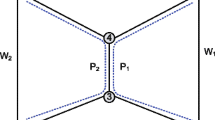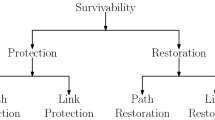Abstract
In this paper, a new shared protection mechanism for meshed optical networks is presented. Significant network design cost reductions can be achieved in comparison to the well-known 1+1 protection scheme. Demand-wise Shared Protection (DSP) is based on the diversification of demand routings and exploits the network connectivity to restrict the number of backup lightpaths needed to provide the desired level of protection. Computational experiments illustrate the benefits of the DSP concept for cost efficient optical network designs.
Similar content being viewed by others
References
A. Zymolka, A. M. C. A. Koster, and R. Wessäly, Transparent optical network design with sparse wavelength conversion. In Proceedings of the 7th IFIP Working Conference on Optical Network Design & Modelling (ONDM 2003), Budapest, Hungary, pp. 61–80, 2003.
R. Bhandari, Survivable Networks, Algorithms for Diverse Routing, Kluwer Academic Publishers, Boston/Dordrecht/London, 1999.
S. De Patre, G. Maier, M. Martinelli, and A. Pattavina, Design of static WDM mesh networks with dedicated path-protection. In Next Generation Optical Network Design and Modelling, Kluwer Academic Publishers, Boston/Dordrecht/London, pp. 281–294, 2003.
C. Mauz, Allocation of spare capacity for shared protection of optical paths in transport networks. In Proceedings of Design of Reliable Communication Networks Workshop (DRCN) 2001, Budapest, Hungary, pp. 22–27, 2001.
A. Groebbens, D. Colle, C. Develder, S. de Maessschalck, M. Pickavet, and P. Demeester, Use of backup trees to improve resource efficiency of MPLS protection mechanisms. In Proceedings of Design of Reliable Communication Networks Workshop (DRCN) 2001, Budapest, Hungary, pp. 152–159, 2001.
E. G. Josza and D. Orincsay, Shared backup path optimization in telecommunication networks. In Proceedings of Design of Reliable Communication Networks Workshop (DRCN) 2001, Budapest, Hungary, pp. 251–257, 2001.
H. Kerivin, B. Liau, and T.-T.-L. Pham, Survivable capacitated networks—Comparison of shared protection mechanisms. In Proceedings of Networks 2002, Munich, Germany, pp. 379–388, 2002.
G. Dahl and M. Stoer, A cutting plane algorithm for multicommodity survivable network design problems. INFORMS Journal on Computing, Vol. 10, No. 1, pp. 1–11, 1998.
W. E. Falconer, Service assurance in modern telecommunications networks. IEEE Communications Magazine, Vol. 28, No. 6, pp. 32–39, 1990.
R. K. Ahuja, T. L. Magnanti, and J. B. Orlin. Network Flows: Theory, Algorithms, and Applications. Prentice Hall, New Jersey, 1993.
OPNET. WDM Guru. See http://www.opnet.com.
G. L. Nemhauser and L. A. Wolsey, Integer and Combinatorial Optimization, Wiley, New York, 1988.
atesio GmbH, Germany. DISCNET, 2000–2004. See http://www.atesio.de.
ILOG. CPLEX version 7.5, 2001. See http://www.ilog.com/products/cplex.
A. Betker, C. Gerlach, R. Hülsermann, M. Jäger, M. Barry, S. Bodamer, J. Späth, C. Gauger, and M. Köhn, Reference Transport Network Scenarios, Technical report, BMBF MultiTeraNet, July 2003. Available from http://www.ikr.uni-stuttgart.de/IKRSimLib/Referenz_JNetze-vl4_Jull.pdf.
R. Hülsermann, S. Bodamer, M. Barry, A. Betker, C. Gauger, M. Jäger, M. Köhn, and J. Späth. A set of typical transport network scenarios for network modelling. In 5. ITG Fachtagung Photonische Netze, Leipzig, pp. 65–71, 2004.
A. Dwivedi and R. E. Wagner, Traffic model for USA long-distance optical network. In OFC 2000, pp. 156–158, 2000.
A. Betker and C. Gerlach, Traffic demand model for national optical transport networks based on the population distribution. In 4 ITG Fachtagung Photonische Netze, Leipzig, pp. 71–76, 2003.
Author information
Authors and Affiliations
Corresponding author
Additional information
Arie M. C. A. Koster studied technical mathematics at Delft University of Technology, The Netherlands. His PhD thesis (University Maastricht, The Netherlands, 1999) deals with models and algorithms for frequency assignment in wireless networks. Currently, he is a researcher at the Zuse Institute Berlin (ZIB). His research interests are in mathematical optimization, algorithmic graph theory, and telecommunciation network design.
Adrian Zymolka studied mathematics at the Philipps University in Marburg, Germany. Since 1999, he has been a research assistant at the Zuse Institute Berlin (ZIB) and works on mathematical optimization in telecommunications. His research focuses on the cost efficient design of survivable optical networks.
Monika Jäger has been a senior scientist in the department of Photonic Networks and Network Architecture at T-Systems, Technologiezentrum in Berlin since 1998. She held previous positions with the Fraunhofer Institute for Open Communication Systems, and DeTeWe. In 1992, She graduated in Electrical Engineering fromMunich University of Technology,Germany.Her current research interests are in the area of optical transport network design.
RalfHälsermann has been a junior research engineer in the department of PhotonicNetworks and Network Architecture at T-Systems Technologiezentrum in Berlin since August 2001. He graduated in 2001 from Deutsche Telekom AG, University of Applied Sciences, Leipzig, Germany. He is currently working on protection and restoration issues in optical networks.
Rights and permissions
About this article
Cite this article
Koster, A.M.C.A., Zymolka, A., Jäger, M. et al. Demand-wise Shared Protection for Meshed Optical Networks. J Netw Syst Manage 13, 35–55 (2005). https://doi.org/10.1007/s10922-005-1855-4
Issue Date:
DOI: https://doi.org/10.1007/s10922-005-1855-4




